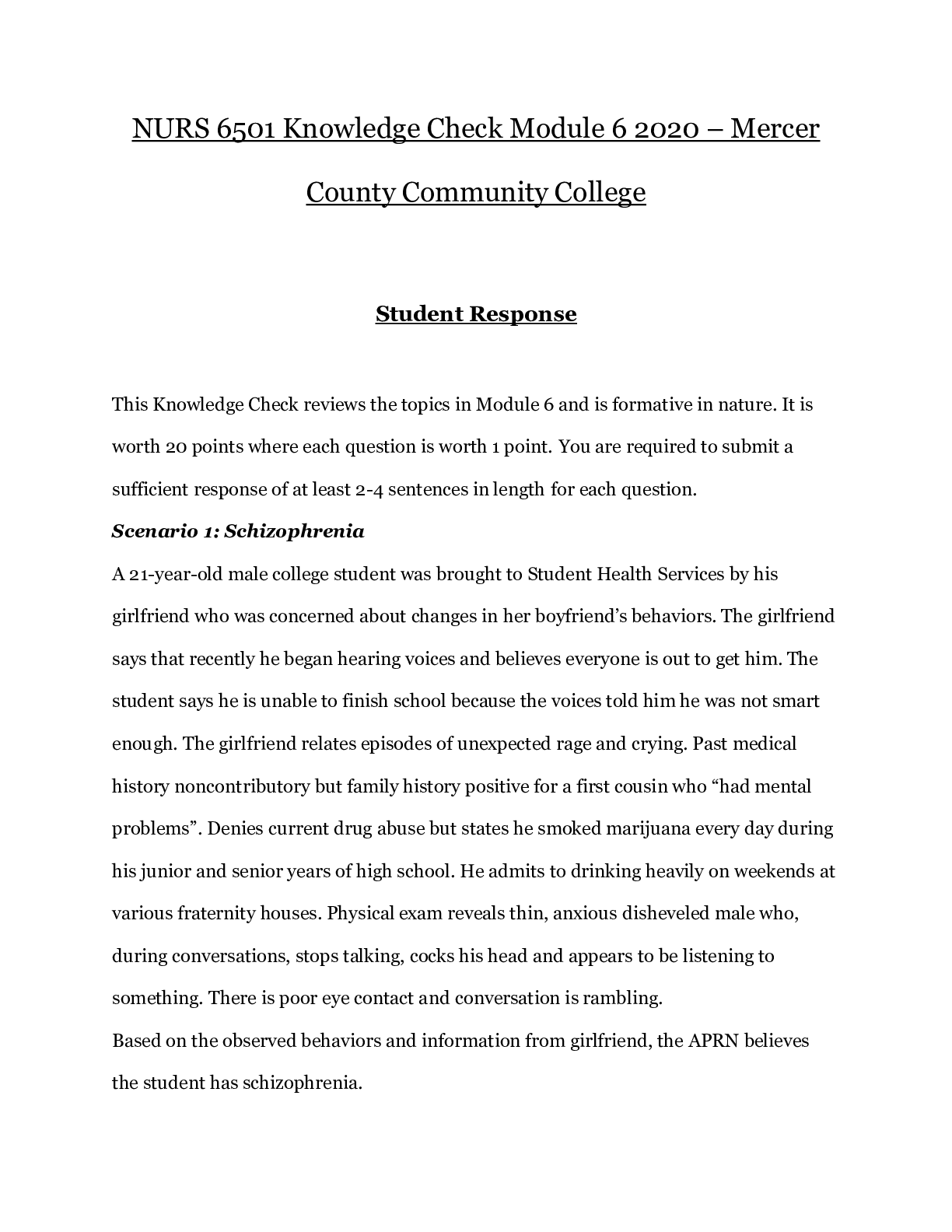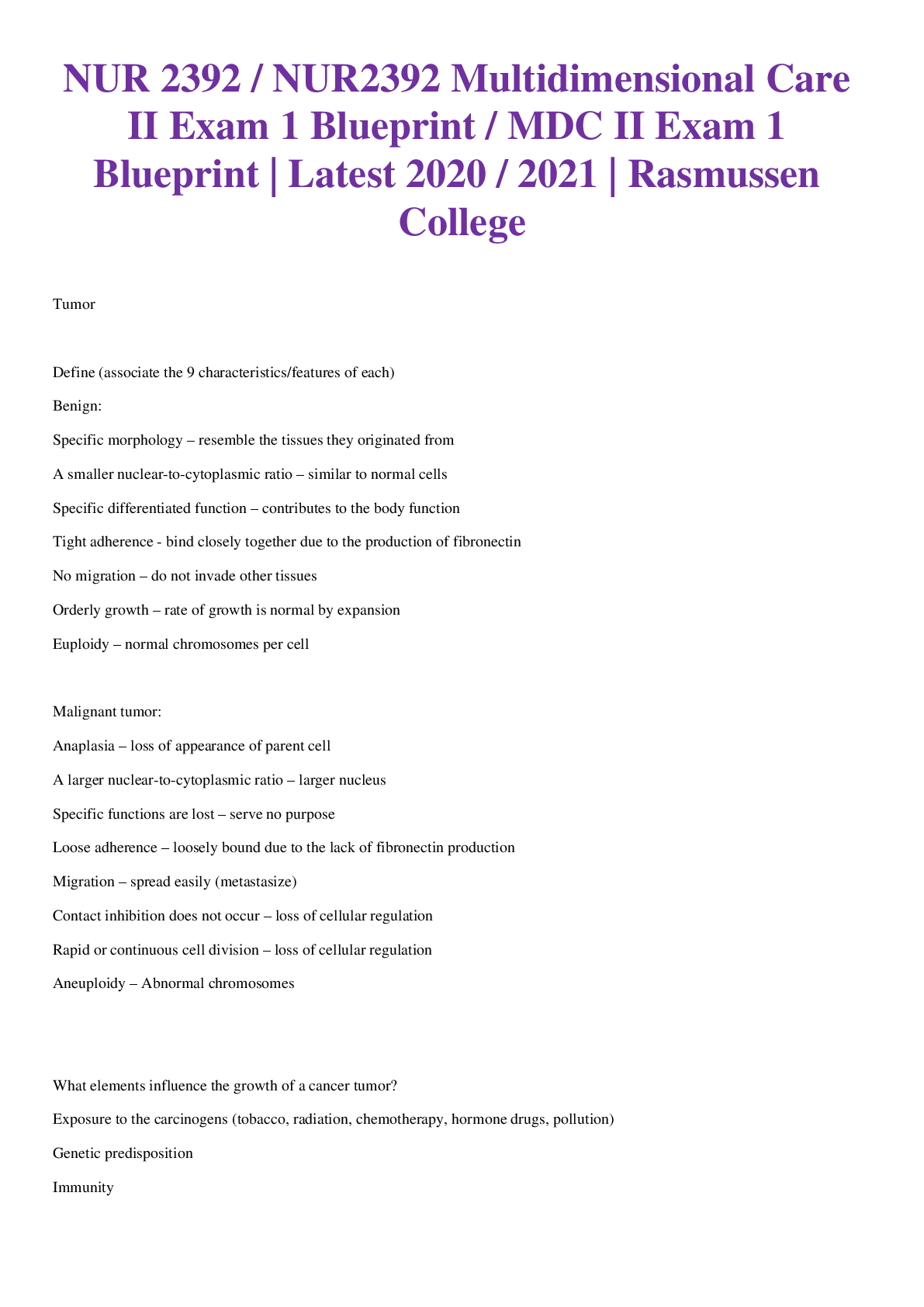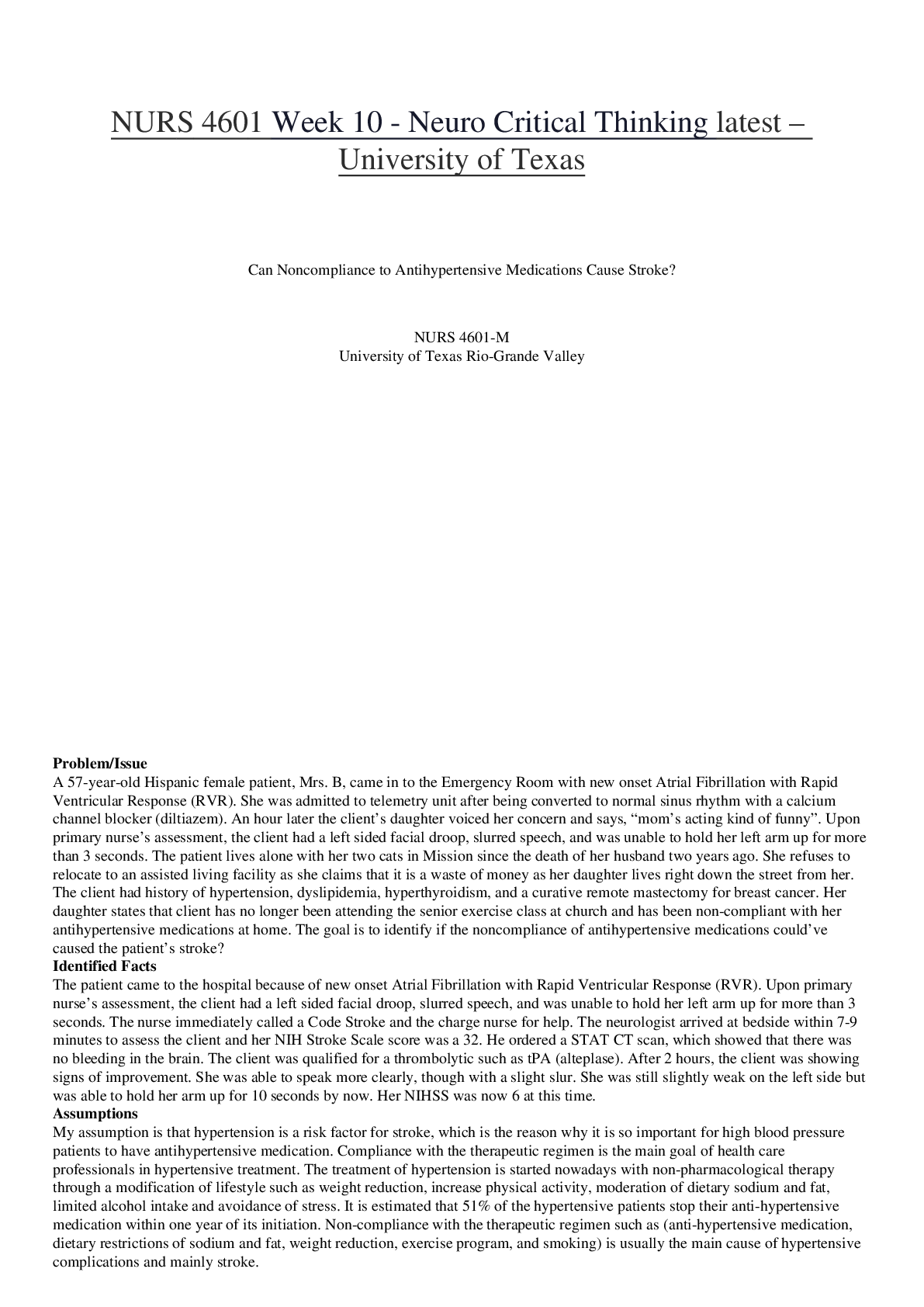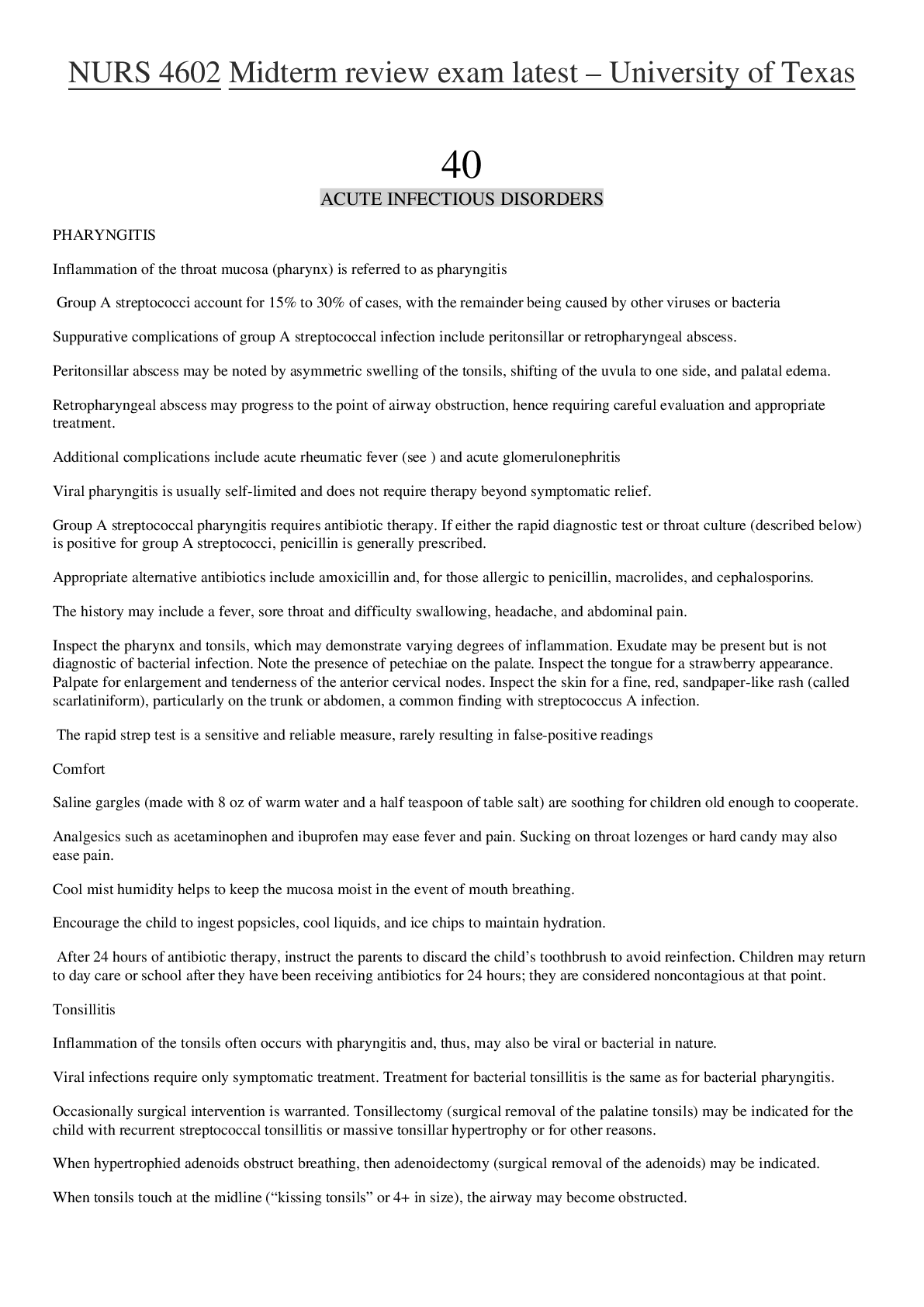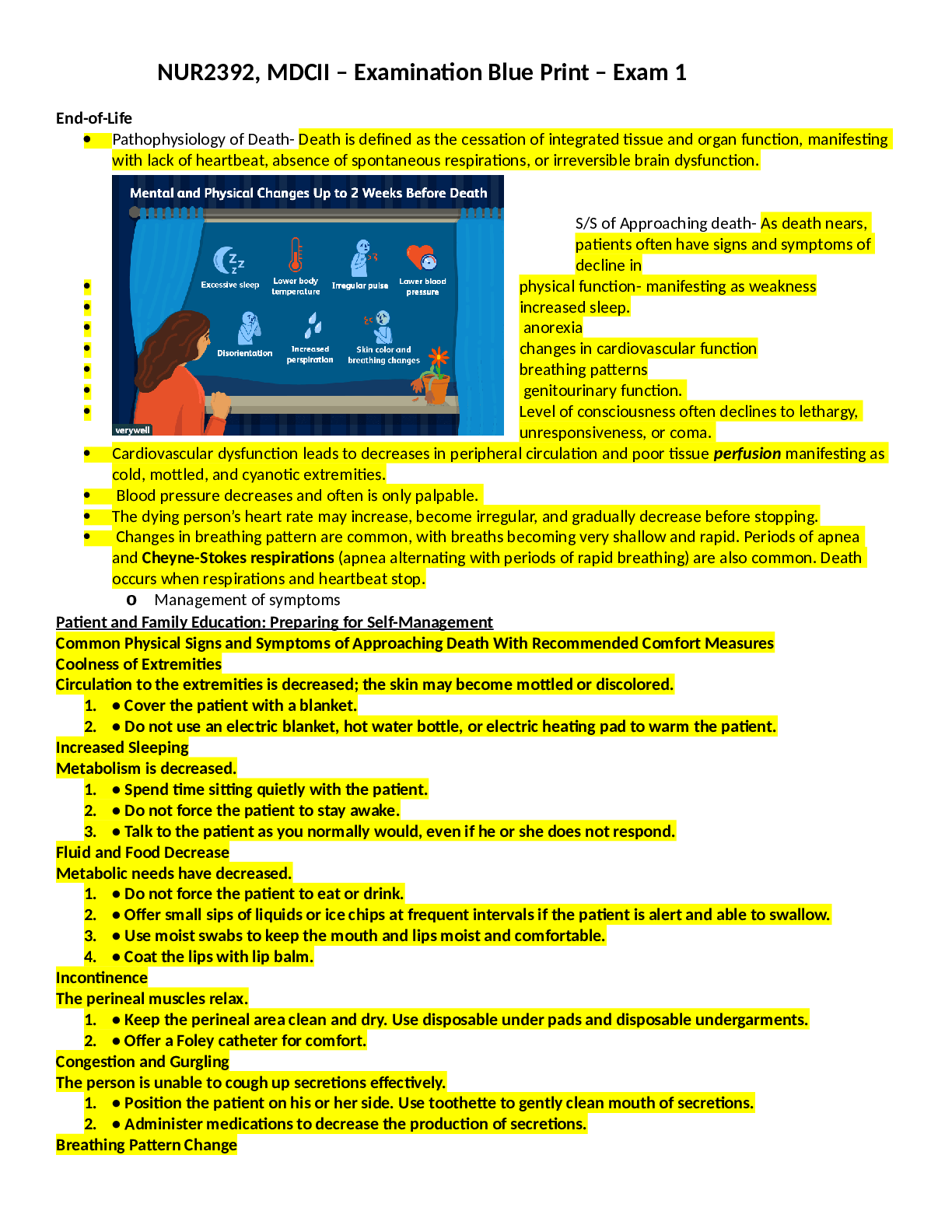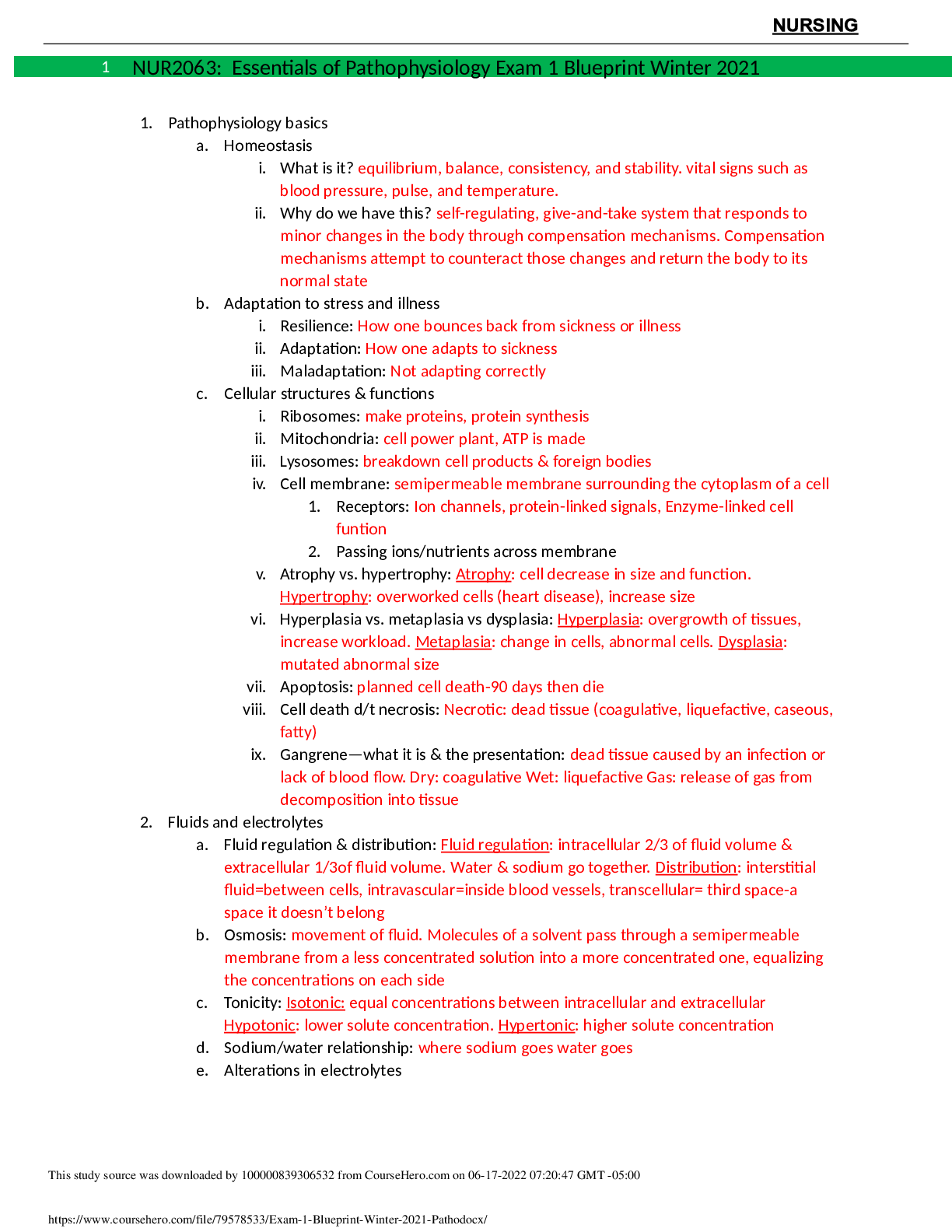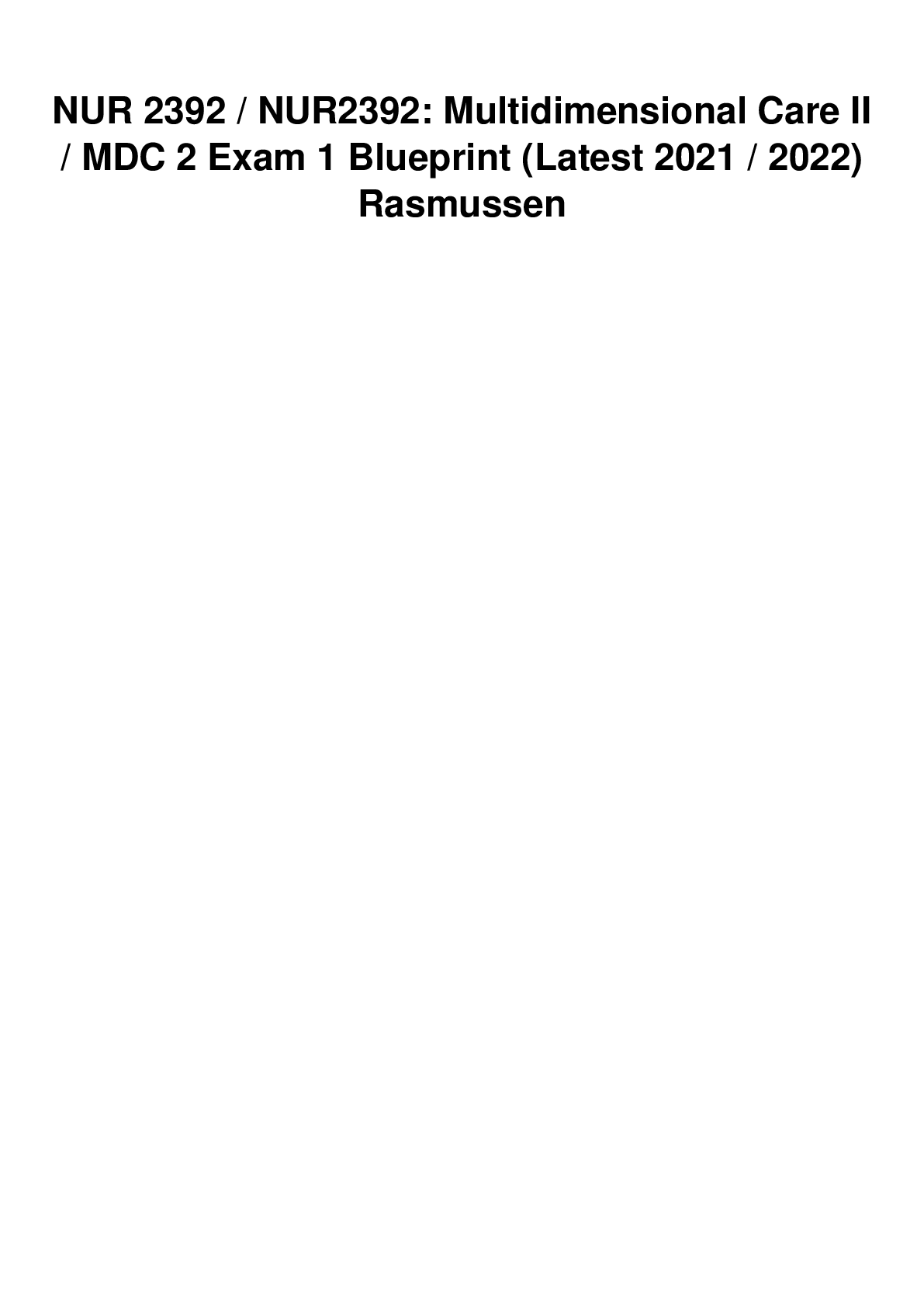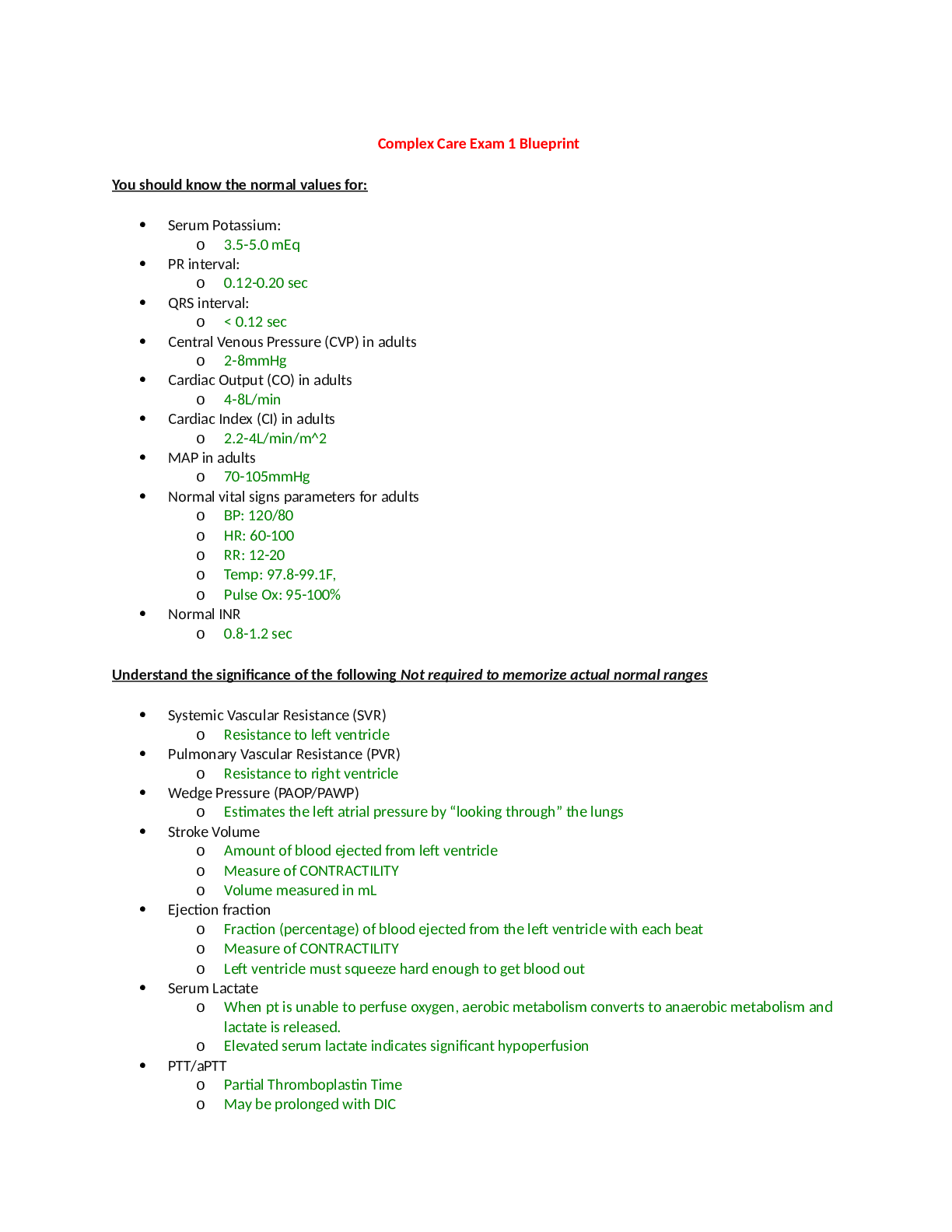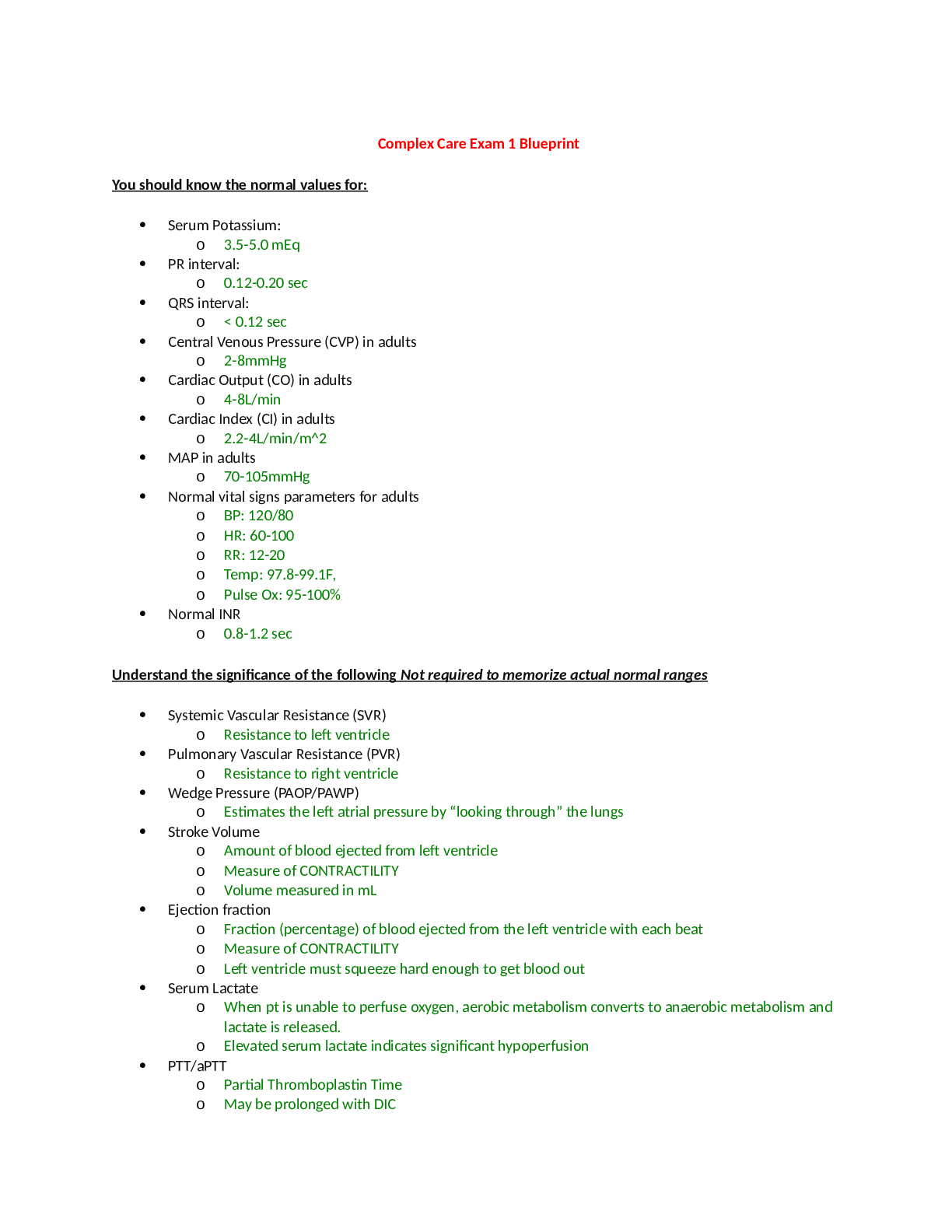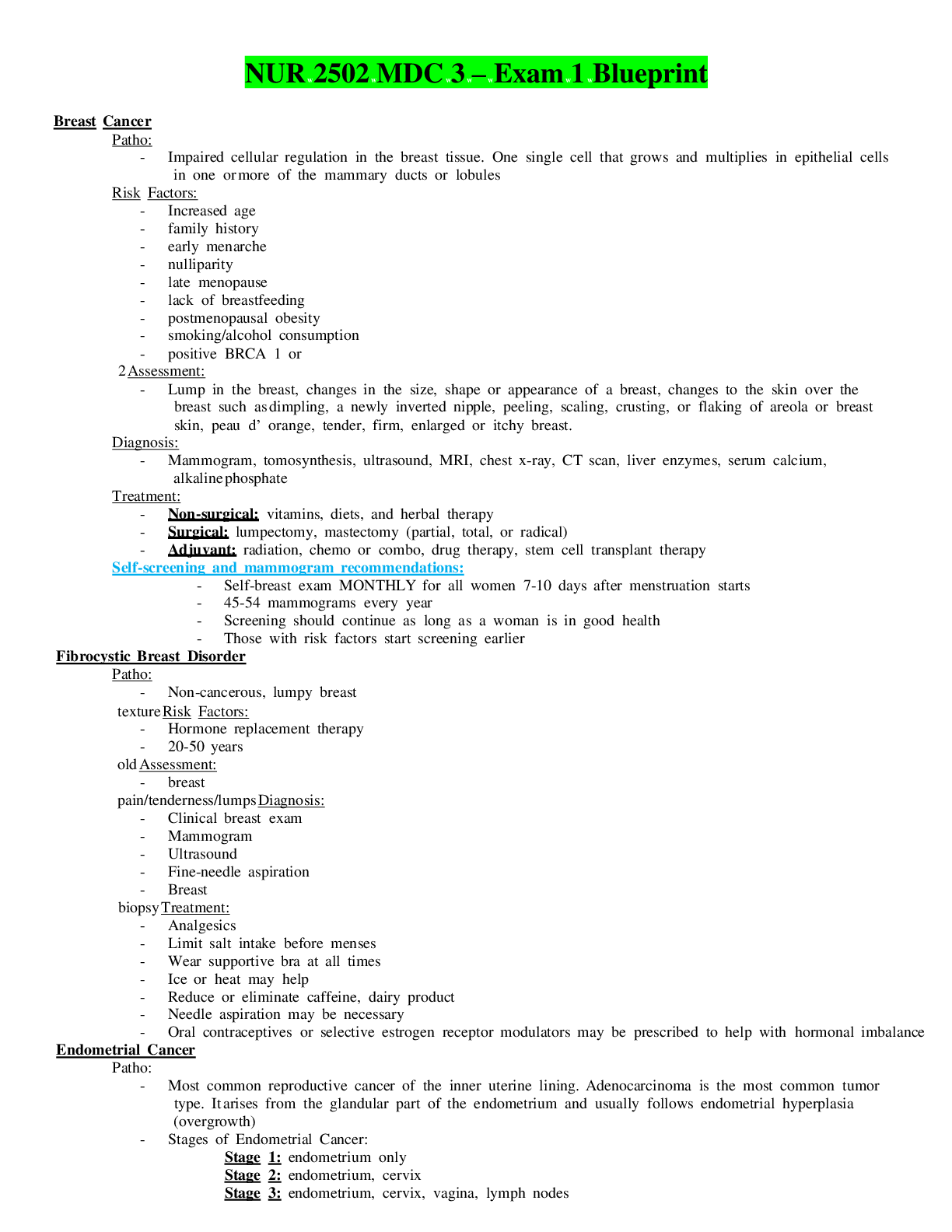NUR 4601 Adult II Exam 1 Blueprint latest – University of Texas
Document Content and Description Below
NUR 4601 Adult II Exam 1 Blueprint latest – University of Texas Adult II Exam 1 Blueprint Issues & Concepts She says there’s a lot of holistic care (body, mind spirit) questions but they are... n’t hard. Tegrity: These things are inner related, inner connected. Particularly in the icu. We are focusing on emergencies (life-threatening) and focusing on that treatment and we often forget their mind. Research has told us for years and years. We used to call it ICU psychosis but now they call it ICU syndrome and people who make it out suffer from psychological damage for years. Its like a post traumatic stress disorder. How come? Because of pain. Have to give them antianxiety and pain meds because research has shown that even suctioning them is a painful procedure. Moving them is painful. So what are other things? You come into the ICU, you totally lose control, you’re no longer in control. Your whole identity is taken away from you. I have seen in practice, you lose your name. Do not depersonalize them. From book Algorithm- step-wise decision-making flow chart for a specific care process or processes. Algorithms are more focused that clinical pathways and guide the clinician through the “if, then” decision-making process, addressing patient responses to particular treatments. Well known examples of algorithms are advanced cardiac life support (acls) algorithms published by the American heart association. Practice guideline- usually developed and written by team of experts representing professional organizations or a governmental agency to provide recommendations to care providers. Recommendations are given for managing care and treatments for specific diseases and are passed on research or expert opinions. Protocol- more directive and rigid than pathways or guidelines and providers should not vary from a protocol. Patients are screened carefully for specific entry criteria before being started on protocol. Tegrity: Quality, safety and regulatory issues- always remember if you made a mistake you want to correct it immediately and you want to tell that patient what happened and what effect theyre going to have. The whole process you must report it and you don’t want it to happen again. Malpractice Pg 14 in Critical care book Legal (Malpractice)- is a type of professional liability based on negligence in which the defendant is held accountable for breach of a duty of care involving special knowledge and skill. • 1st element: a duty, or legal obligation, requires the person (“actor”) to conform to a certain standard of conduct for the protection of others against unreasonable risks. The standard is that owed at the time the incident or injury occurred, not at the time of litigation. In most jurisdictions the standard of care is a national standard. • 2nd element: breach of duty, involves a failure on the actor’s part to conform to the standard required. • 3rd element: involves proving that the actor’s breach was reasonably close or causally connected to the resulting injury referred as proximate cause. • 4th element: injury or damage, must involve an actual loss or damage to the plaintiff or his or her interest. Plaintiff may claim diff types of damages such as compensatory and punitive. Plaintiff may provide evidence of damages and their value. Res ipsa loquitur, “the thing speaks for itself,” is a rule of evidence used by plaintiffs in negligence or malpractice litigation. For example, negligence can be inferred when muscle ischemia and necrosis occur as a result of improper body positioning and the application of splints or restraints. Also inferred from a foreign object left in a patient’s body cavity after surgery. Organ donation -Required for you to ask the patient -Required by law to as a potential candidate to be a donor Advance Directives (Pg. 39) Advance directives: Written documents that allow the individual of sound mind to document preferences regarding end-of-life care that should be followed when the signer is terminally ill and unable to verbally communicate his or her wishes. The documents are generally completed in advance of serious illness, but may be completed after a diagnosis of serious illness if the signer is still sound of mind. The most common types are the durable power of attorney for health care and the living will - Durable power of attorney for health care: A legal document through which the signer appoints and authorizes another individual to make medical decisions on his or her behalf when he or she is no longer able to speak for him- or herself. This is also known as a health care power of attorney or a proxy directive. - Living will: A type of advance directive in which the individual documents treatment preferences. It provides instructions for care in the event that the signer is terminally ill and not able to communicate his or her wishes directly and often is accompanied by durable power of attorney for health care. This is also known as a medical directive or treatment directive. Patient & Family education - Adult learning principles: o Must be ready to learn - Teaching Learning Process o Continuous and ongoing - Education Plan Development - Essential Critical Care Information for the Patient/Family Phases and Priorities • Initial contact/first visit • Continuous Care • Transfer • Planning for Discharge Teaching Methods: • Lecture • Discussion • Demonstration and practice • Written Materials -- - - - - - - - - – Complete heart block – Or after open heart Use to override refractory tachycardias – SVT – VT – Fast AF Functions in two ways: 1) Fixed (asynchronous pacing) - initiates impulse at a set rate regardless of the patient’s own intrinsic rate. If I set that pacemaker at 80 bpm, it's going to beat at 80 bpm, regardless of what the patient's heart rate is beating. So it competes, and is potentially very dangerous. 2) Demand (synchronous pacing) - It can be used for asystole and during surgery. Electrical magnetic interference can be a problem. You kind of have to remember that. A big magnet can really affect pacemaker function. Demand pacemakers sense the patients own intrinsic heart rate and then do not discharge an impulse if the patient has a rate that is adequate. o Single chamber o Dual chamber Failure to Fire - You have complete heart block and your pacemaker is no longer working. Failure to Sense - Pacemaker didn’t sense the pt’s heart beat and fired anyway; this is very dangerous because it can occur during the relative refractory period. Failure to Capture - If you lose capture, first thing you want to do, turn the pt over so the lead will be in better contact with ventricle, or you might have to turn up the output, or change the battery. Always make sure you have extra 9-bolt batteries – It’s your job. Over Sensing - It doesn’t fire when it should, it is sensing the T wave or the P wave and not firing; this is also dangerous because it can occur during the relative refractory period. • Continuously monitor EKG (for at least 24 hours) • Recognize and care for malfunction o We have to always secure temporary pacing, leads, bridging cable to the patients because we don’t want them to become dislodged. • Protect patient from micro shock (Problem with epicardial) o Micro-shocked: A low level of electric current applied directly to myocardial tissue; as little as 0.1 mA causes ventricular fibrillation. o Coming back from surgery – Pt is hooked to a temporary pacemaker: ♣ If the pt is not hooked to a cable or temporary pacemaker then we can accidently give them micro-shocks ♣ Always handle the patient with gloves, and keep them wrapped in a finger cott, or a needle cap ♣ Have the wires that are hanging out tapped to them ♣ Static electricity can go right through those wires and into the person, so you have to keep the person grounded, covered, always wear rubber gloves if they’re not hooked to the cable • Monitor for complications (Problem for temporary trans venous) o Tamponade - Pressure on the heart that occurs when blood or fluid builds up in the space between the heart muscle (myocardium) and the outer covering sac of the heart (pericardium). o Insertion site infection. Always maintain aseptic technique. • Patient Education o Permanent: ♣ Inform them to notify the nurse if anything is wet or lose. ♣ Don’t use home electric equipment. ♣ Limited activity (Nowadays, they usually don’t immobilize the arm to much because is jugular insertion but they do have a very limited activity but not for more than a week.) ♣ Avoid high impact on implantation site (avoid contact sports, or shooting) ♣ Be alert for symptoms of failure such as syncope, chest pain, and fluid retention. ♣ Patient needs to know their pacemaker rate. (if your pacemaker is set at 70, you should have a pulse of 70) ♣ Teach them how to check their pulse. ♣ Report signs of infection - redness, edema, fever, drainage, soreness. Malfunction Teach client to check own pule and if the pacemaker is set to 60 and own pulse is 52 this is a sign of malfunction. Failure to fire spikes and captures and then stops spiking. Turn MA up. If it is external pacemaker then check the batteries. First thing to do whether it is temporary or permanent is you will turn them to either side. Usually it is the left side. It may be a battery problem and then have cardiologist change the battery. Failure to sense: if temporary change battery, tighten connections and replace generator. The problem with failure to sense your own beat it may spike on the t wave and send patient into V tachycardia. Turn up sensitivity. Over sensing: unexplained pauses. He sensitivity must be turned up. ICD ICD: implantable cardioverter defibrillator • Multi-tiered therapy o Anti-tachycardia pacing o Bradycardia backup pacing o Low energy cardioversion o High energy defibrillation • Nursing care: o Patients require antidysrhythmic medications From ECG book page 206: • The ICD is a surgically implanted device to deliver an electric shock directly to the heart during a life threatening tachycardia • Treatment option for chronic, recurrent VT Calculations MAP: SBP +( 2 DBP)/3 • Normal range 70 to 100 mm Hg Systemic vascular resistance (SVR) • MAP – RAP X 80 • CO » Normal range 800 to 1200 dynes/sec/cm – Pulmonary Vascular Resistance – PAMP - PAOP X 80 – CO » normal range 250 dynes/secs/cm • B/P = CO x SVR [Show More]
Last updated: 1 year ago
Preview 1 out of 60 pages

Reviews( 0 )
Document information
Connected school, study & course
About the document
Uploaded On
May 20, 2020
Number of pages
60
Written in
Additional information
This document has been written for:
Uploaded
May 20, 2020
Downloads
0
Views
44


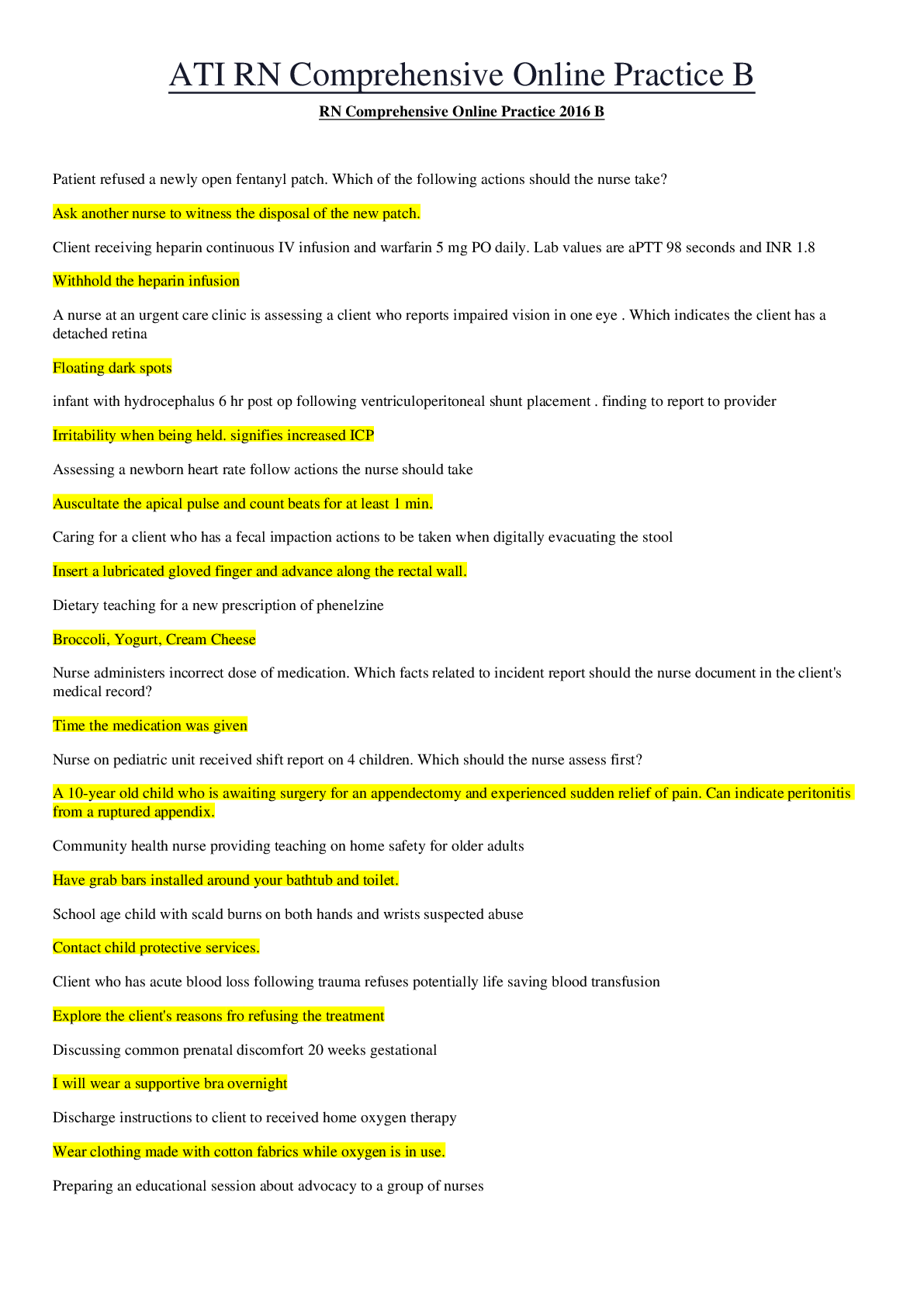
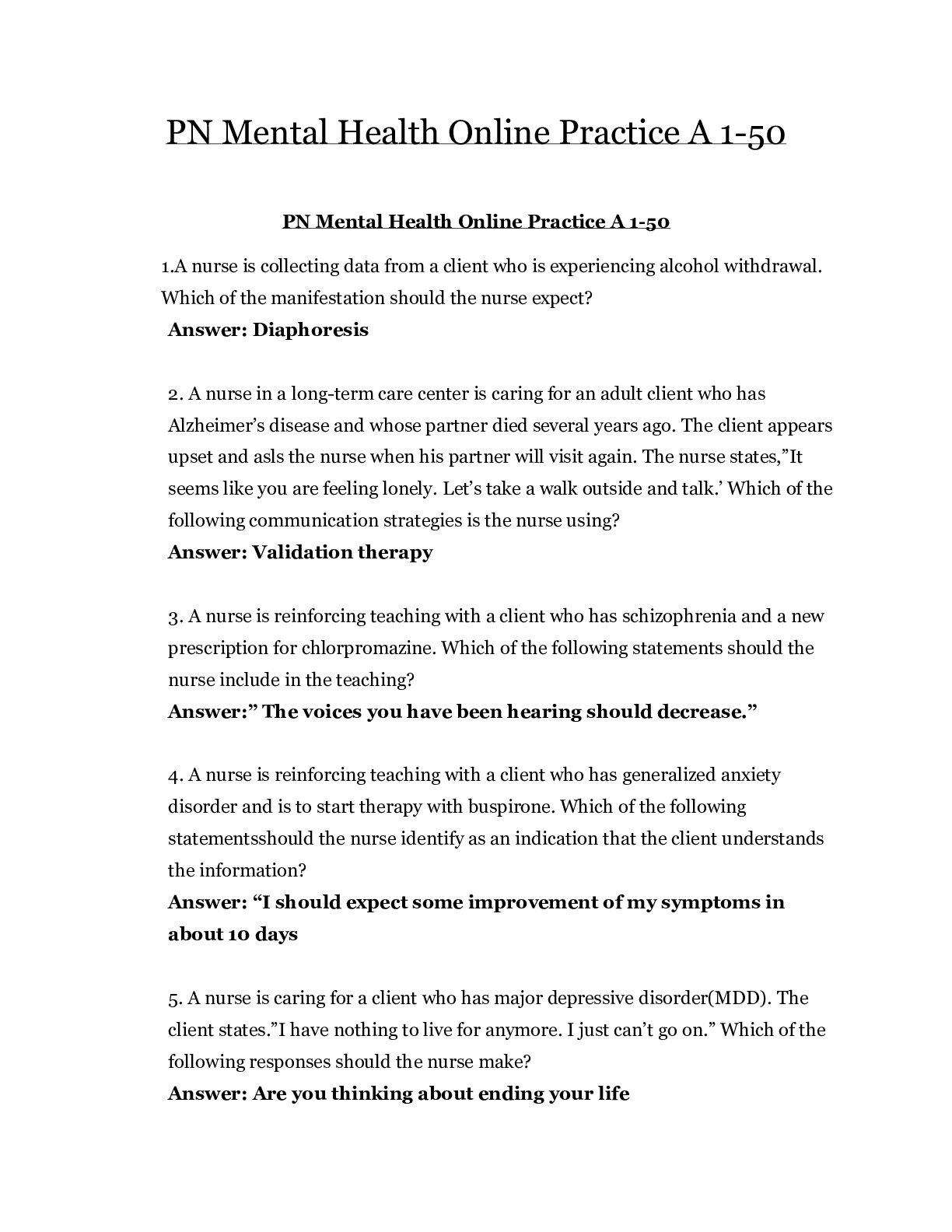
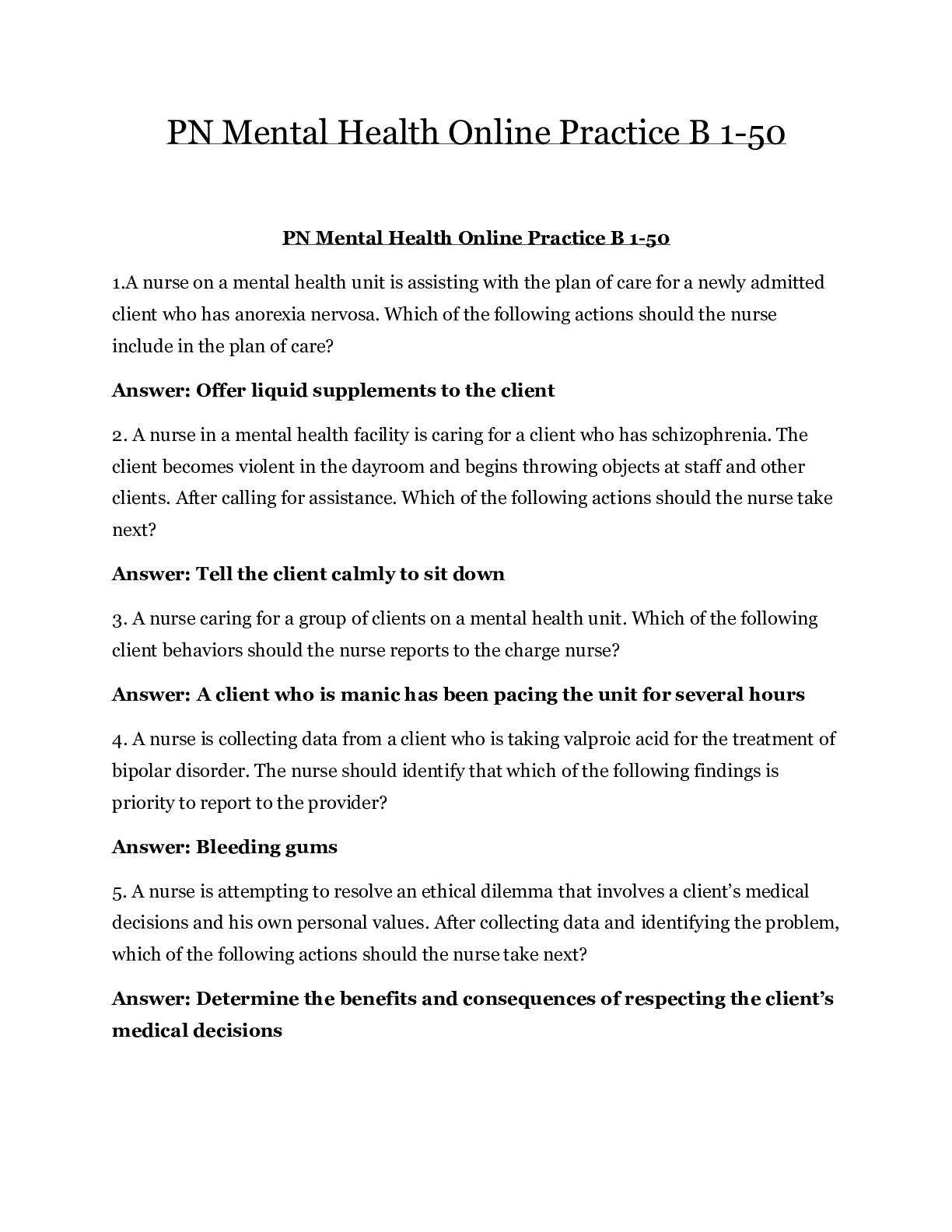
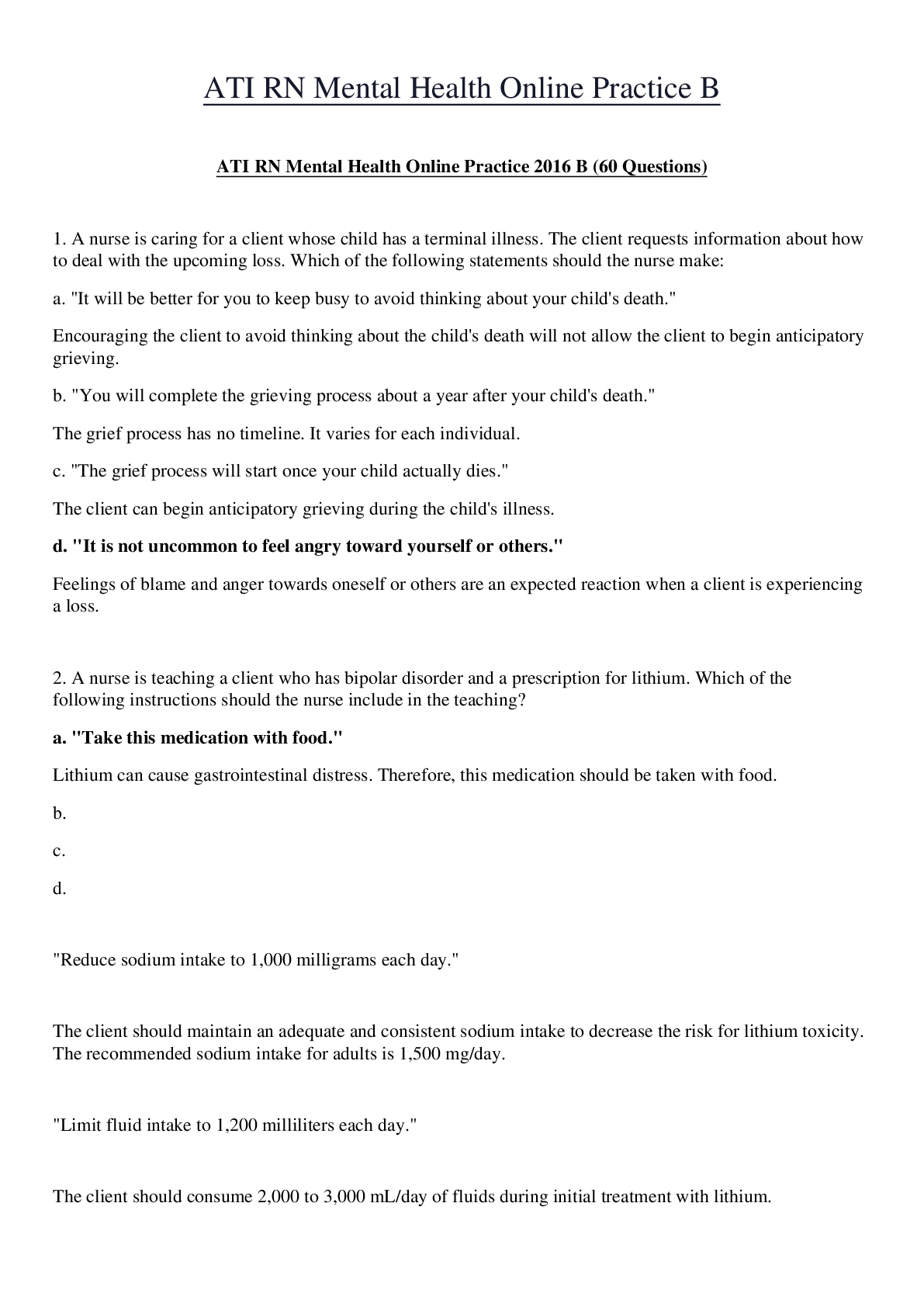

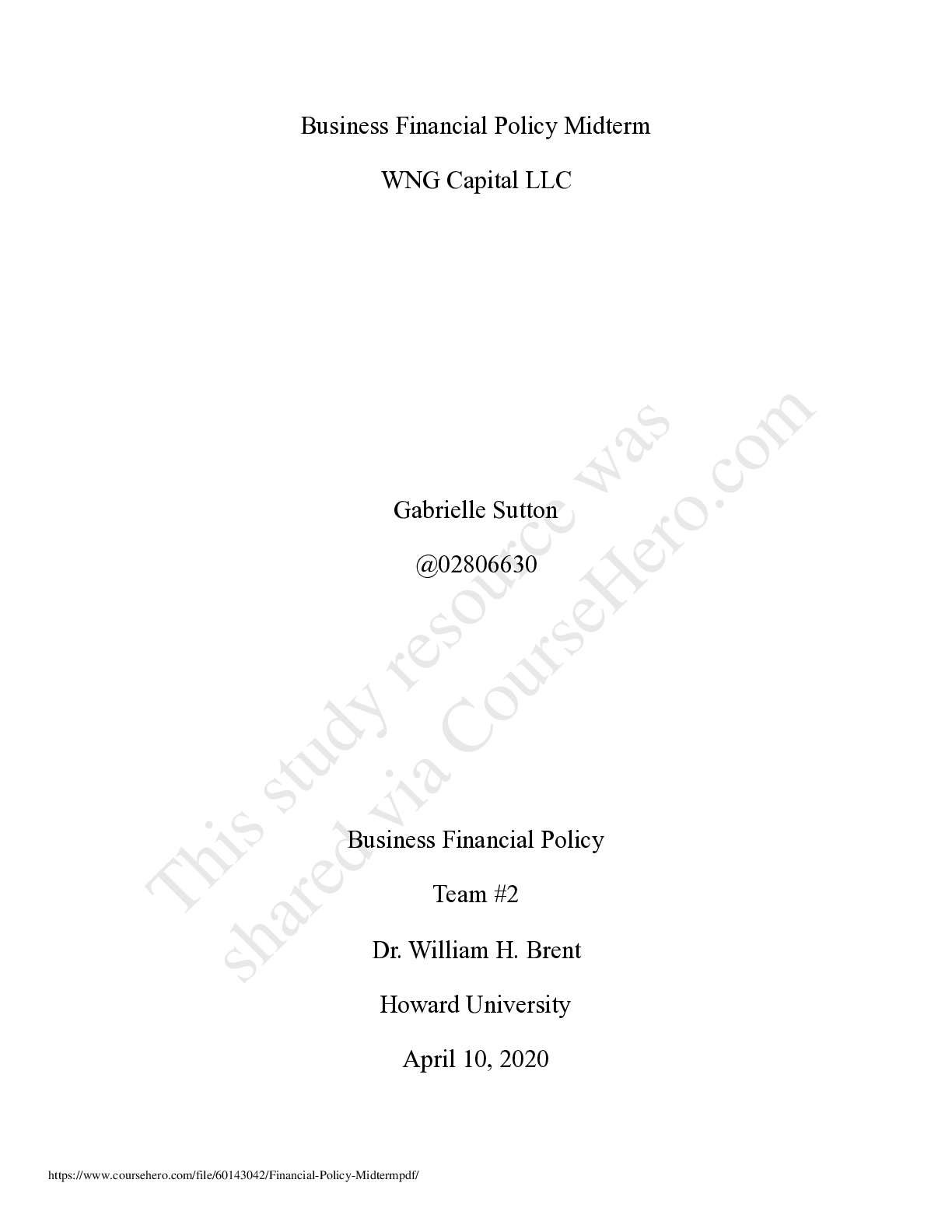
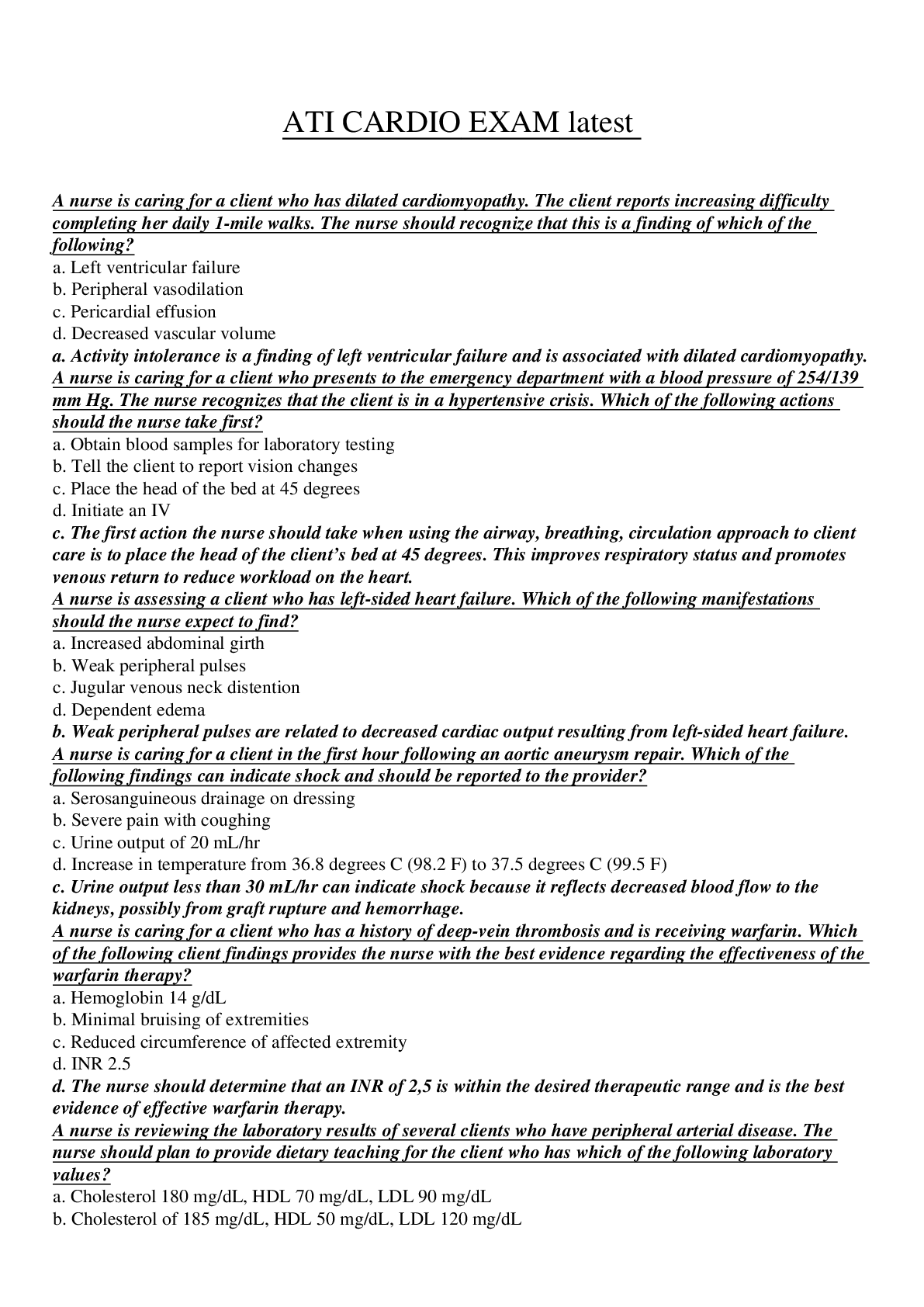
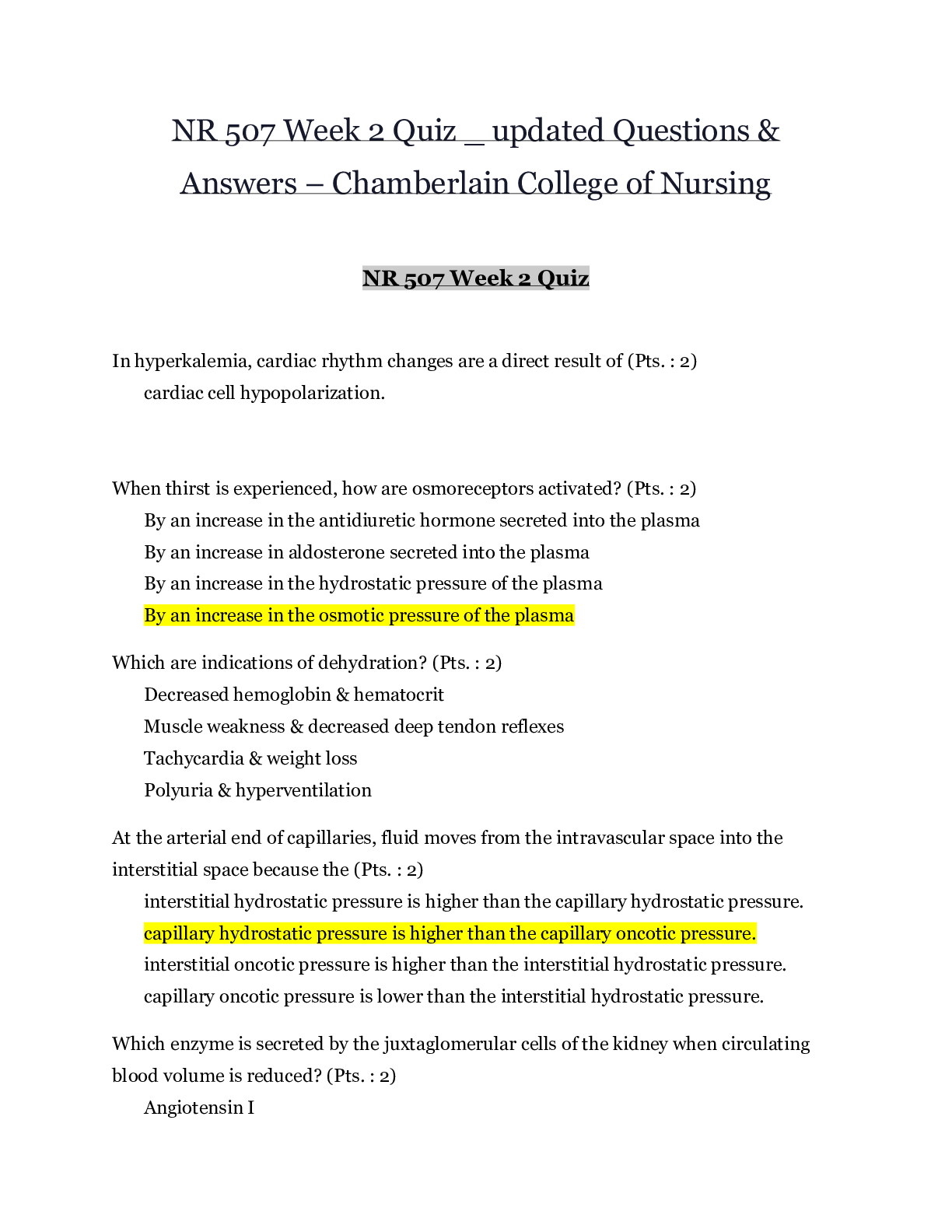
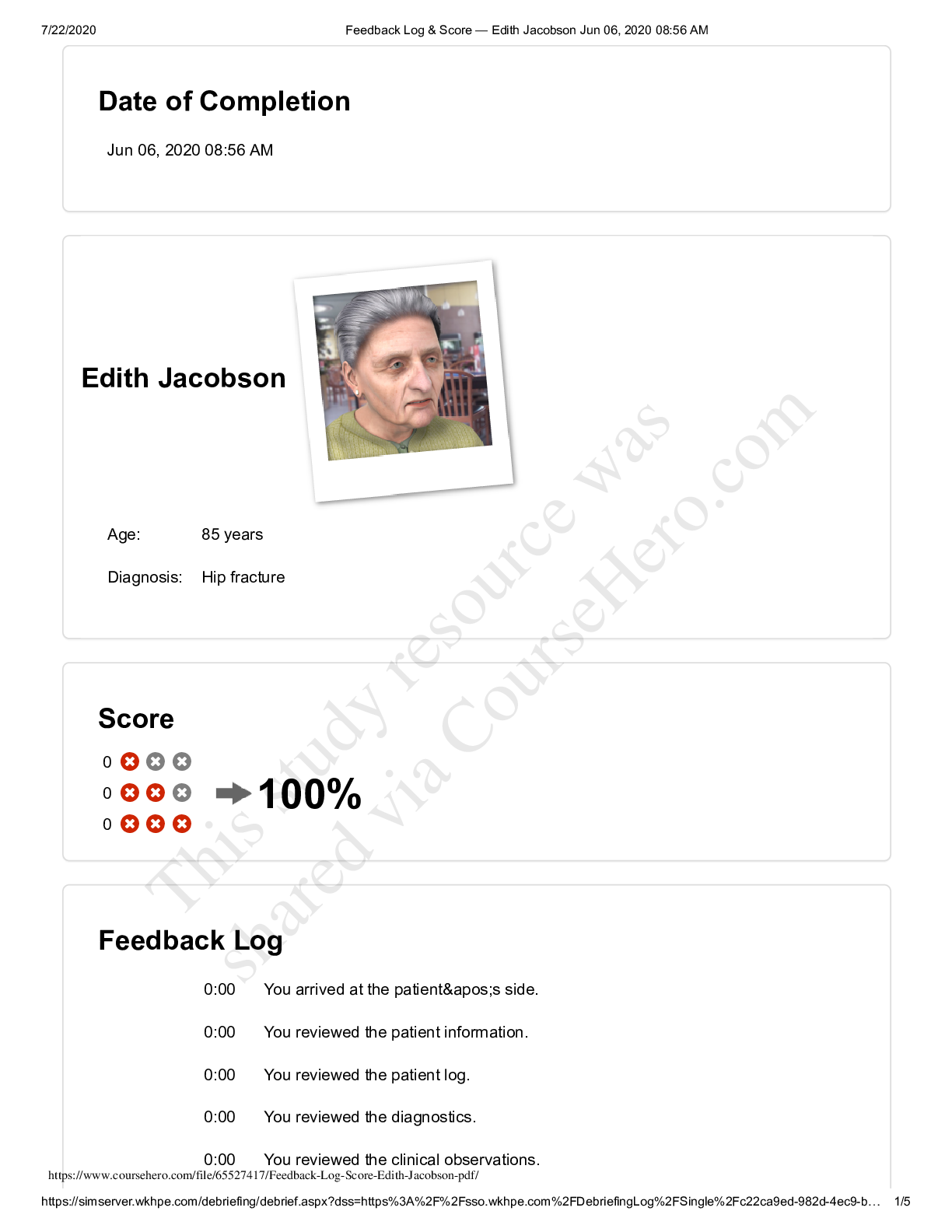
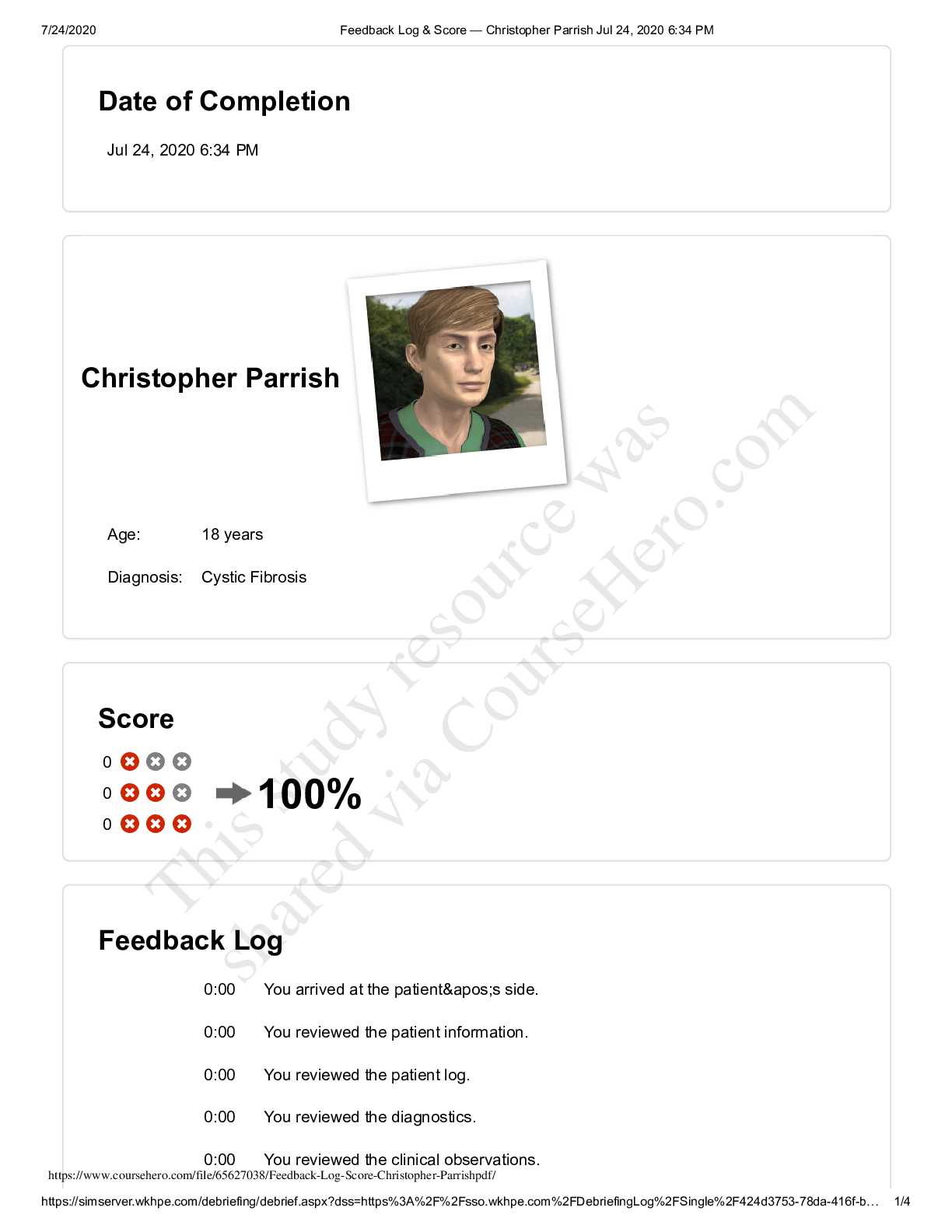
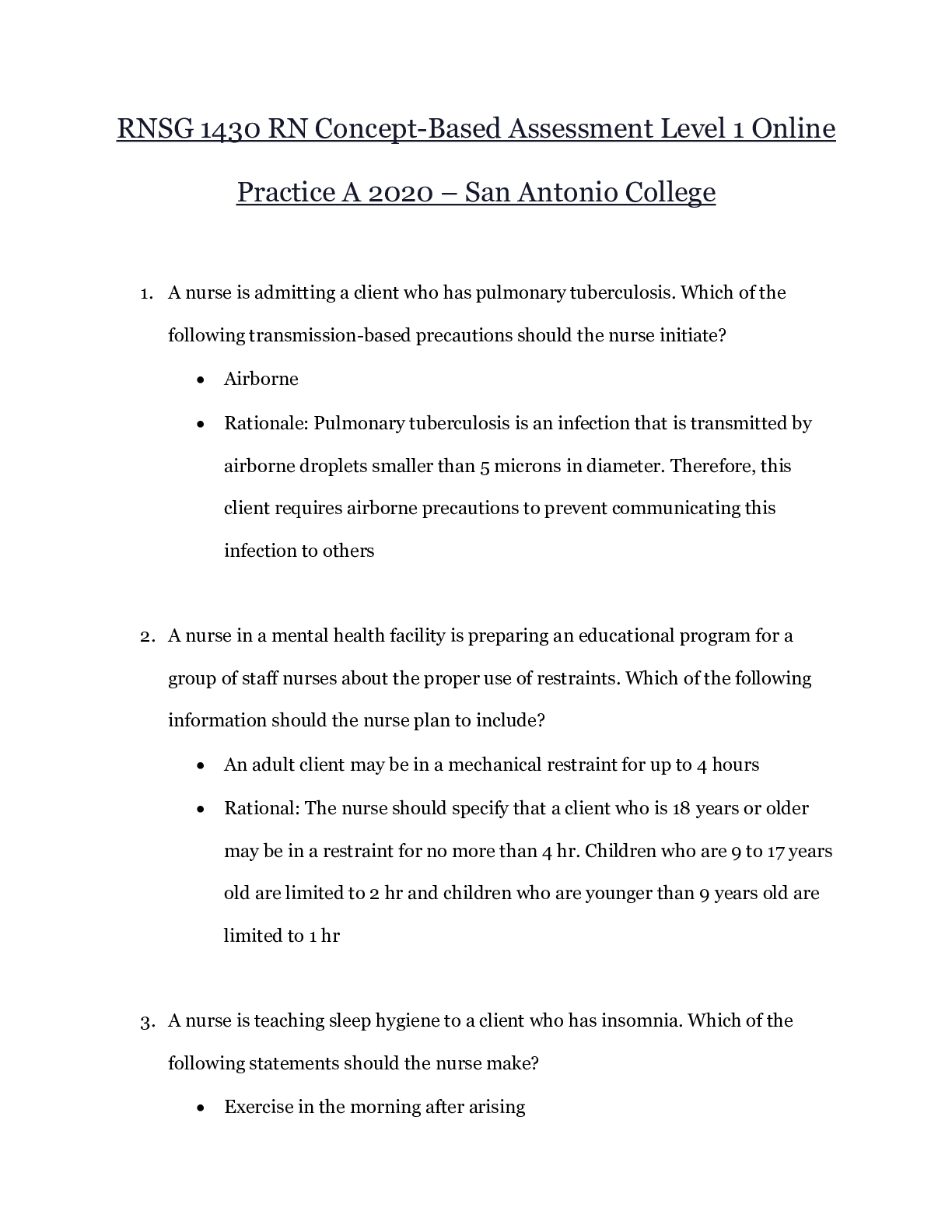


 – CHAMBERLAIN COLLEGE OF NURSING.png)
